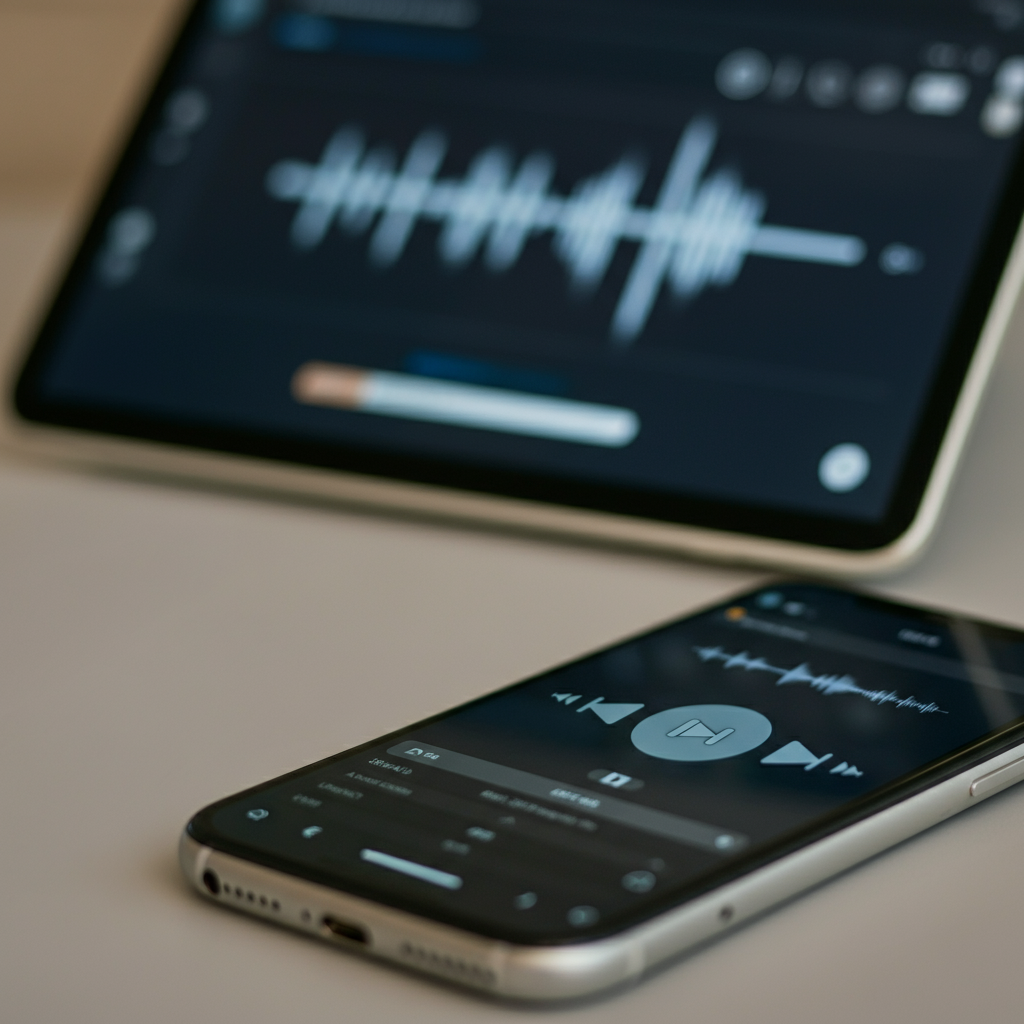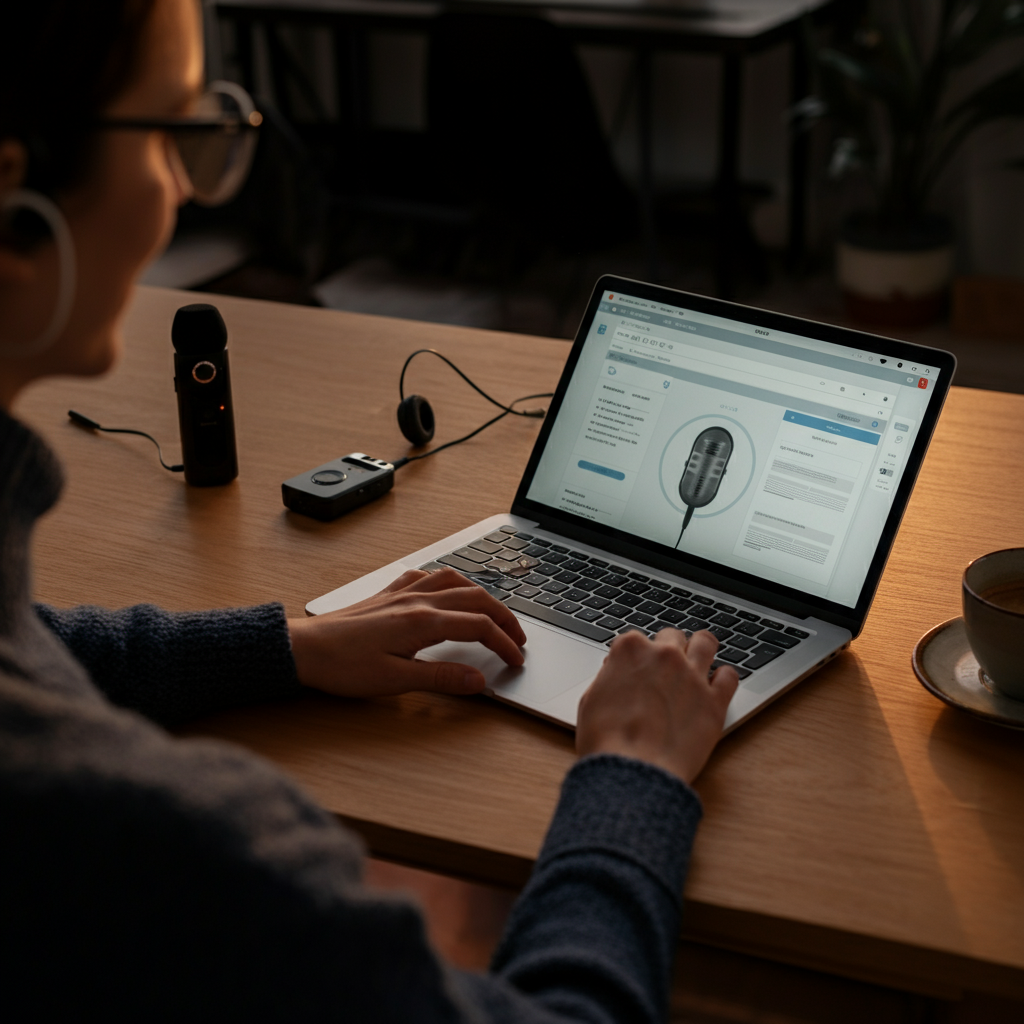Technology
|
19 June 2025
How to Transcribe Voice Memos Easily: Best Methods and Tools
Written by Faizan
Full Stack Developer
Learn how to transcribe voice memos effectively with manual methods, apps, and professional services. Find the best tools and tips for accurate transcription.

Table of Contents
Voice memos are an excellent tool for capturing ideas, interviews, meetings, and more on the go. But voice recordings aren't always practical for reviewing or sharing; that's where transcription comes in.
If you're looking to learn how to transcribe voice memos into text, this ultimate guide will walk you through the most effective methods, their pros and cons, and actionable steps to get started.

Whether you prefer manual transcription, apps, or professional services, we've got you covered.
We'll also discuss tools like Riverside and Descript to make the process seamless. Let's explore how you can easily convert voice memos to text.
Why Transcribing Voice Memos Matters
Transcribing voice memos allows you to turn spoken words into searchable and shareable text. Here's how it can benefit you:
- Accessibility: Text is easier to skim, share, or repurpose for documents and content creation.
- Efficiency: Quickly refer back to key points without re-listening to entire recordings.
- Professionalism: Present text-based meeting minutes or interview insights to colleagues or clients.
What You'll Learn in This Blog:
Methods to transcribe voice memos, including manual and automated options.
Tools for voice memo transcription and their benefits.
A comparison of transcription methods to help you choose the best one.
Related keywords covered in this blog include:
- Voice memo transcription
- Convert voice memo to text
- Speech-to-text tools
Methods to Transcribe Voice Memos
There's no one-size-fits-all solution for transcribing voice memos. Depending on your needs, you can opt for manual transcription, transcription apps, or professional services.
1. Manual Transcription
Manual transcription is the process of listening to your voice memo and typing out the text yourself. The steps involved are simple but time-consuming:
How to Transcribe Manually:
Play your voice memo on a compatible device.
Open a word processor (e.g., Google Docs, Microsoft Word, or Notepad).
Listen to the recording and type what you hear, pausing or rewinding as necessary.
Review your text after transcription to correct any errors.
Pros:
- Cost-effective: No additional software or service costs.
- Highly accurate: You're in complete control of the details.
- Offline option: Can be done without internet access.
Cons:
- Time-intensive: Takes significantly longer for lengthy recordings.
- Fatigue: Requires focus and effort, especially for complex audio.
Best for: Short and clear voice memos where high accuracy is required but time isn’t a constraint.
2. Transcription Apps
Transcription apps leverage speech-to-text technology to automate the transcription process. These tools are faster than manual methods and are designed for convenience.
Example Tools:
- Riverside
- Features AI-powered transcription with speaker identification and timestamping. Ideal for creating precise, accurate transcripts in over 100 languages. Visit Riverside's transcription tool.
- Descript
- Combines transcription, text-based editing, and captions. Perfect for professionals managing podcasts, videos, or meeting transcriptions. Learn more Convert YouTube to MP3 Converter
How to Use Transcription Apps:
Download and install your chosen transcription app.
Upload your voice memo file. Supported formats usually include MP3, WAV, and M4A.
Wait for the app to process. Most apps generate transcripts in seconds to minutes.
Review and edit the text for accuracy if needed.
Export the file in your preferred text format (TXT, SRT, etc.).
Pros:
- Fast and efficient: Save hours, especially for long recordings.
- User-friendly: Easy to operate, even for beginners.
- Additional features: Many apps include features like text editing and caption generation.
Cons:
- Not always free: Tools often require a subscription for full functionalities.
- Accuracy varies: Challenging audio with background noise may require manual correction.
Best for: Transcribing interviews, meetings, or podcasts when speed and basic accuracy are essential.
3. Professional Transcription Services
Professional services use expert human transcriptionists or advanced AI to produce precise, high-quality transcripts. Some popular options include Rev, Otter.ai, and Scribie.

How Professional Services Work:
Visit the service’s website and create an account.
Upload your audio file and set transcription preferences (e.g., verbatim or edited transcripts).
Confirm your order and pay accordingly; pricing typically depends on audio duration.
Download your completed transcript once available.
Pros:
- Highly Accurate: Human transcriptionists handle nuance, accents, and technical jargon better than AI.
- Customizable: Choose options like timestamps or speaker labels.
- Saves effort: Outsource the entire task.
Cons:
- Expensive: Costs can add up for lengthy recordings.
- Processing time: May take hours or days, depending on the service.
Best for: Businesses or professionals needing high-quality, polished transcripts quickly.
Comparing Transcription Methods
Manual Transcription
- Time Required: High, as it involves listening and typing manually.
- Cost: Free; no extra software or services needed.
- Accuracy: Very high since you're in complete control of the process.
- Best For: Short, clear recordings where precision is essential.
Transcription Apps
- Time Required: Low; these tools automate transcription and deliver quick results.
- Cost: Free to moderate, depending on app features or subscription plans.
- Accuracy: Moderate; suitable for clear audio but may need some manual edits.
- Best For: Quick transcription of interviews, meetings, or casual recordings.
Professional Services
- Time Required: Moderate to high, depending on service turnaround times.
- Cost: Moderate to high; priced per audio minute for detailed results.
- Accuracy: Highest; ideal for complex or critical recordings.
- Best For: Lengthy, important, or technical recordings requiring professional polish.
Actionable Tips for Better Transcription
Improve Audio Quality:
- Minimize background noise during recording.
- Use a high-quality microphone or voice recording app.
Choose the Right Tool:
- For quick transcriptions, try apps like Riverside or Descript.
- For professional-grade results, consider hiring a transcription service.
Proofread Carefully:
- Spend additional time reviewing the transcript for errors and missed nuances.
Consider SRT Files for Video Projects:
- If your transcription includes subtitles, download the file in SRT format to include timestamps.
Leverage AI for Efficiency:
- Tools like Descript allow simultaneous editing of text and associated audio/video media.
External Resources
For more in-depth guidance on transcription tools and their features:
- Top Transcription Software and Services
- Explore the best options for converting audio to text effectively. Learn more here.
Final Thoughts
Converting voice memos into text has never been easier, thanks to the array of tools and services available today. Whether you opt for manual transcription, user-friendly apps, or professional services, your choice depends on your specific needs like audio length, budget, and required accuracy.
Start with an option suitable to your requirements and experiment until you find the right fit.
With tools like Riverside and Descript offering innovative features, transcription can be fast, accurate, and effortless. Now, take the first step to streamline your workflow by transcribing your next voice memo!
FAQs on How to Transcribe Voice Memos
What is the best app for transcribing voice memos?
The top apps for transcribing voice memos include:
- Riverside - An AI-powered tool that provides accurate transcriptions with features like speaker tags and timestamps. It supports over 100 languages.
- Descript - A versatile app offering transcription, text-based editing, and even the ability to edit audio and video simultaneously.
- Both apps are user-friendly and ideal for various transcription needs.
Can I transcribe voice memos for free?
Yes, many tools offer free transcription options. For example:
- Riverside’s free transcription tool lets you transcribe short files.
- Descript provides 1 transcription hour per month in its free plan.
- Keep in mind that free versions may have limitations on functionality or export formats.
How accurate are transcription apps?
The accuracy of transcription apps depends on:
- Audio quality: Clear recordings with minimal background noise lead to better results.
- Speech clarity: Tools may struggle with heavy accents or mumbled speech.
- While apps like Riverside and Descript offer high accuracy, minor manual edits might still be needed.
What file formats are supported by transcription tools?
Most transcription tools support popular audio and video file formats, including:
- MP3
- WAV
- M4A
- MOV
- MP4
- Always check your tool’s compatibility before uploading files.
Is manual transcription better than using an app?
Manual transcription offers higher accuracy since you’re controlling the process, but it’s time-consuming. Apps are faster and more convenient, though they may require some manual editing for perfect results. Choose based on your needs for speed, accuracy, and effort.
Are transcription services worth the cost?
Professional transcription services are worth it if:
- You’re dealing with lengthy or critical recordings.
- You need highly polished and accurate results.
- These services often charge per audio minute but save you time and guarantee top accuracy.
Can I transcribe voice memos without internet access?
Manual transcription can be done offline using a word processor. Some apps like Descript have offline editing features, but automatic transcription often requires an internet connection.
How do I choose the right transcription method?
Consider:
- Your budget: Free or subscription-based tools vs. paid professional services.
- Time availability: Apps and services save more time compared to manual transcription.
- Audio complexity: Difficult or noisy recordings might benefit from human transcriptionists.
Do transcription tools support multiple languages?
Yes, many advanced tools like Riverside support transcription in over 100 languages. Make sure the tool you choose handles the specific language or dialect of your recording.
How can I improve transcription accuracy?
- Record in a quiet environment with minimal background noise.
- Use a high-quality microphone for clear audio.
- Review and edit the transcript for errors after processing.
For further assistance with tools and transcription tips, check out Riverside’s transcription tool.
Revolutionize Your Workflow with Transcripter
Ready to streamline your content creation?
